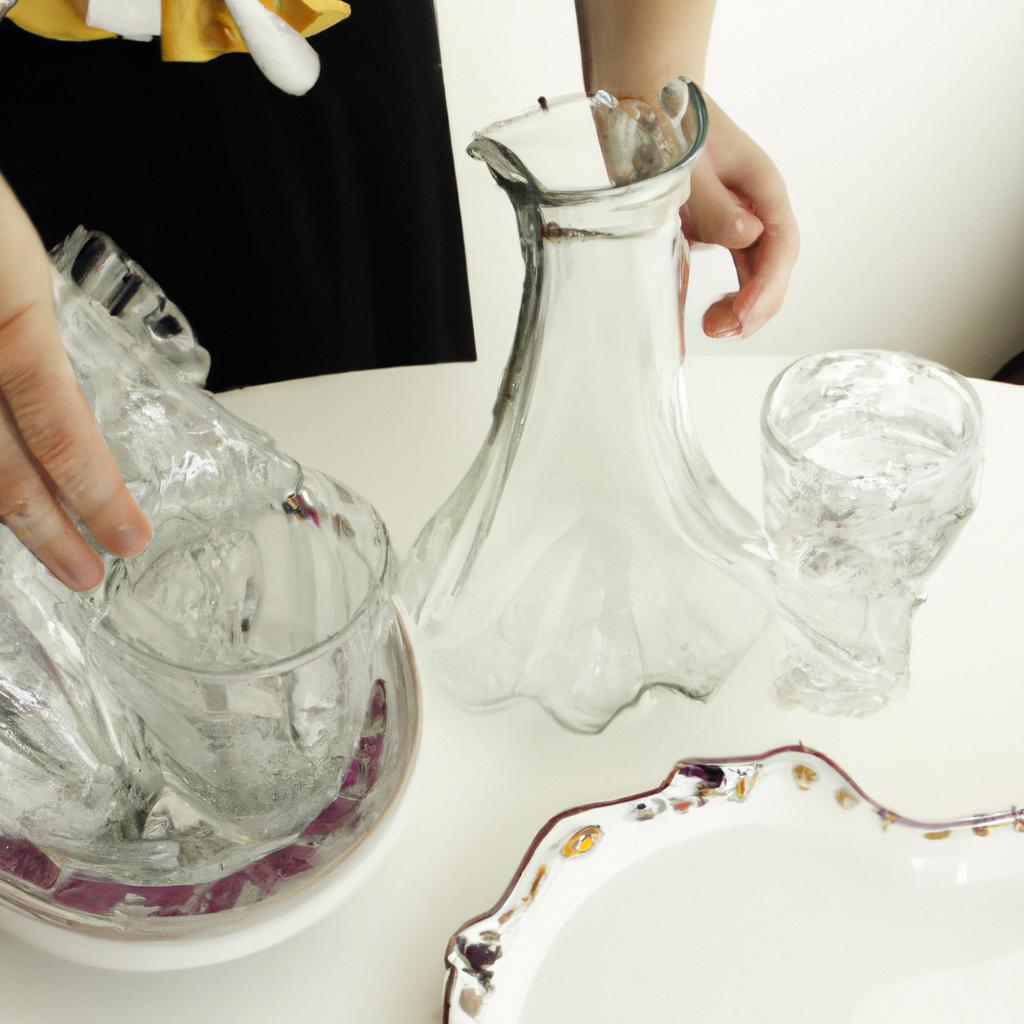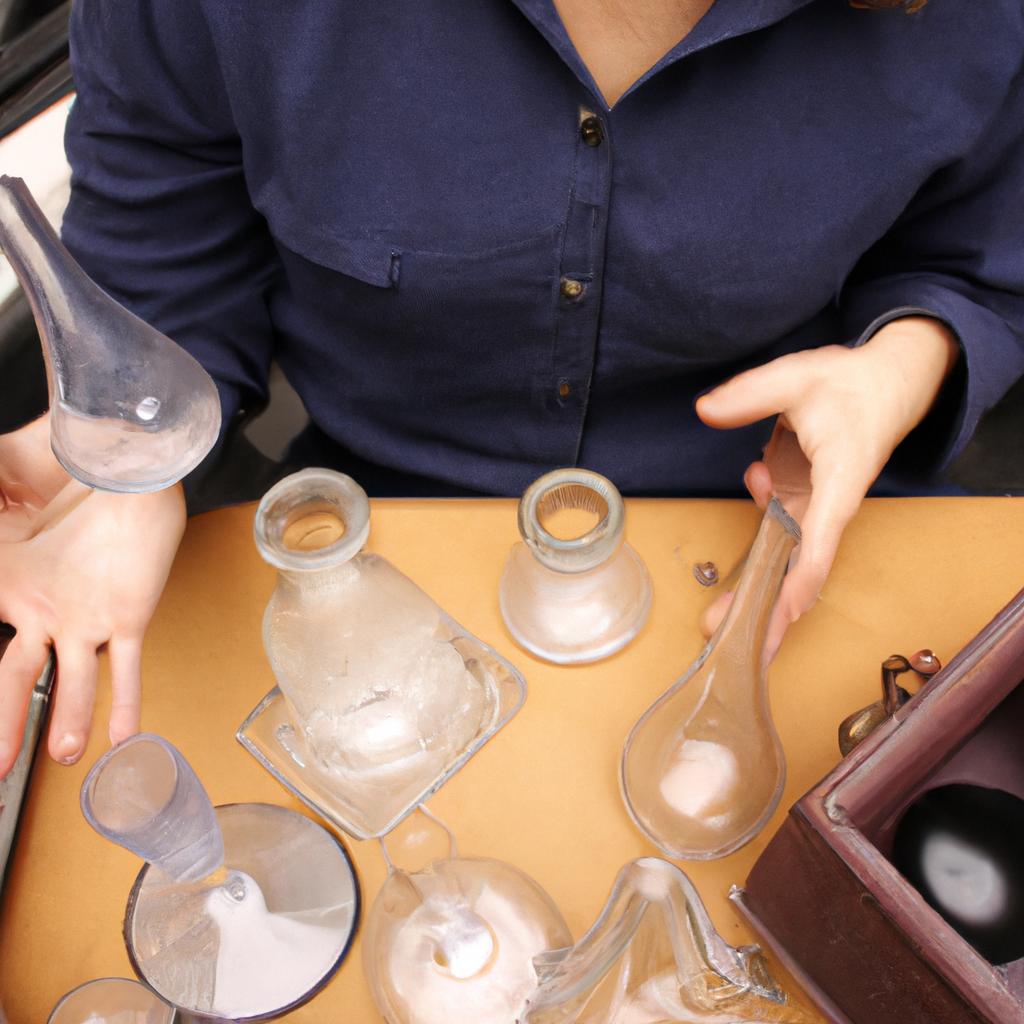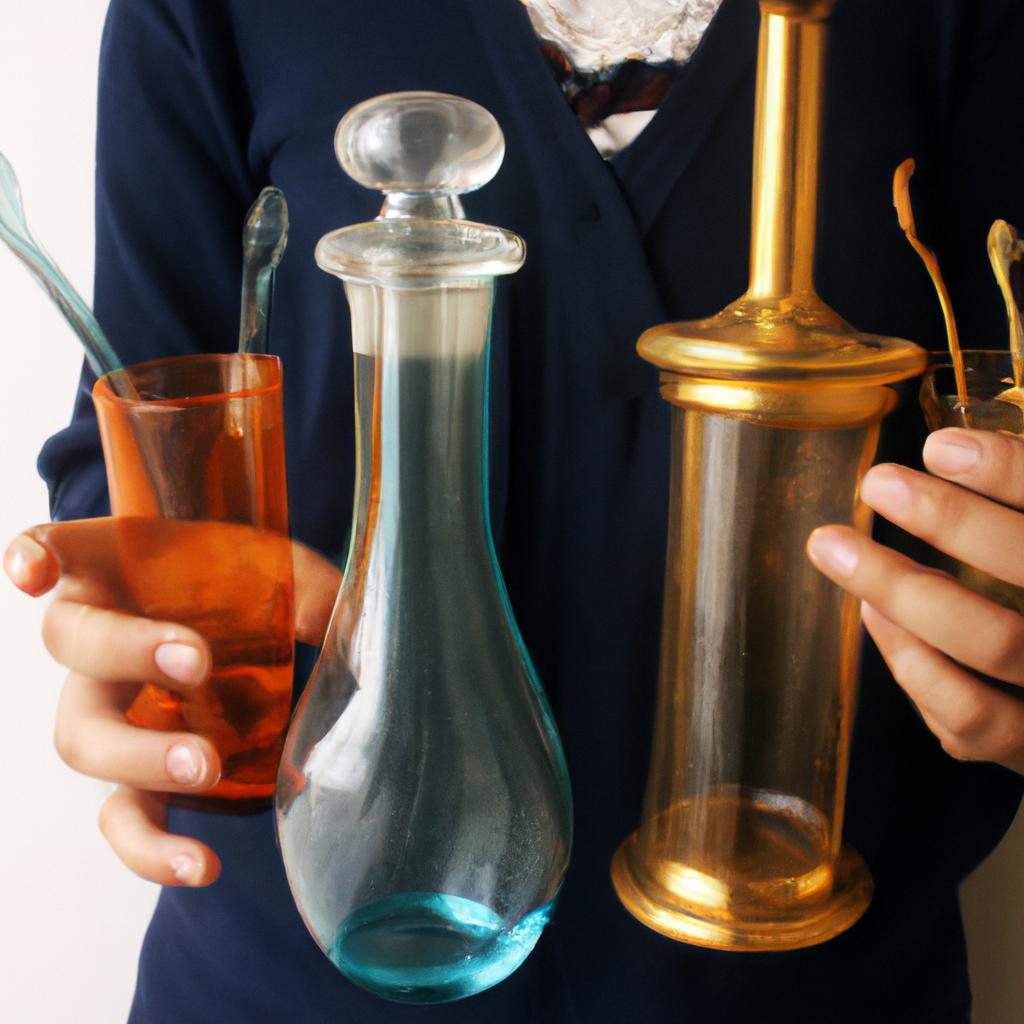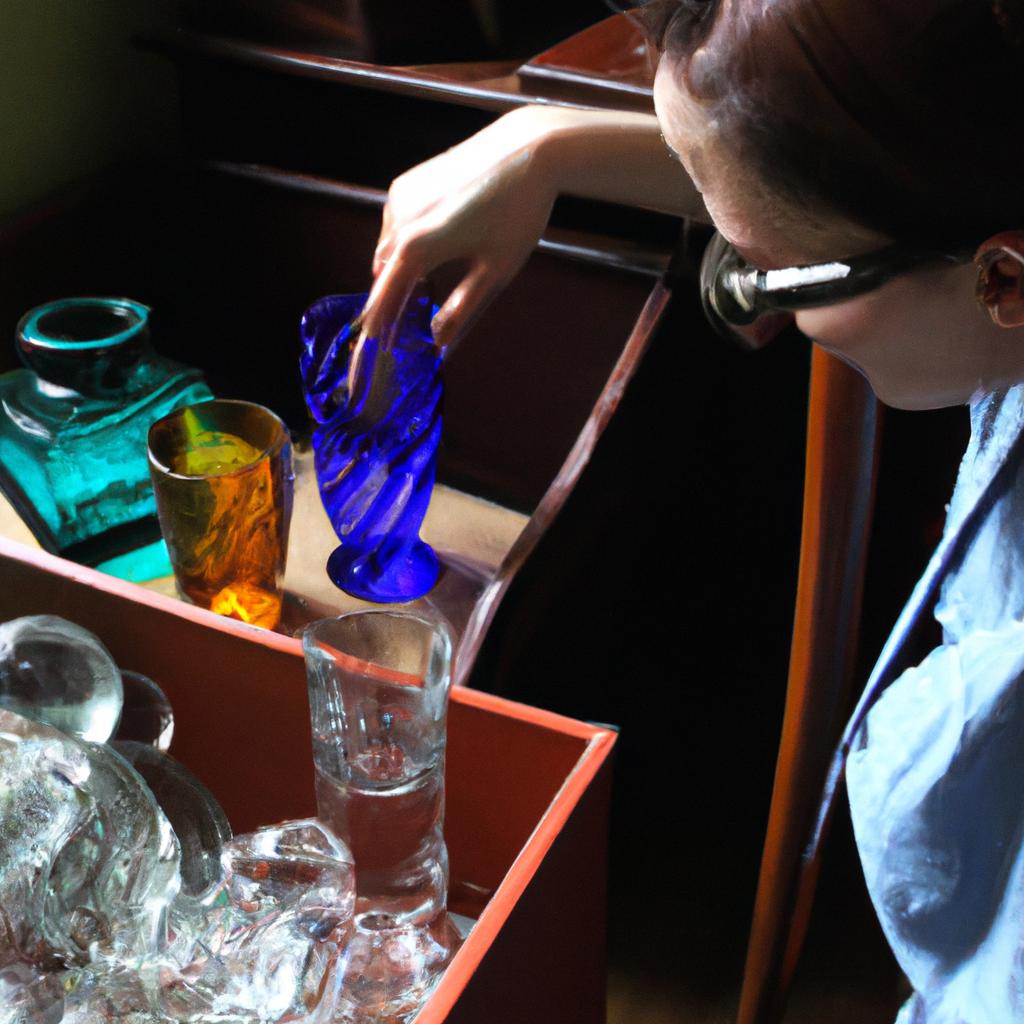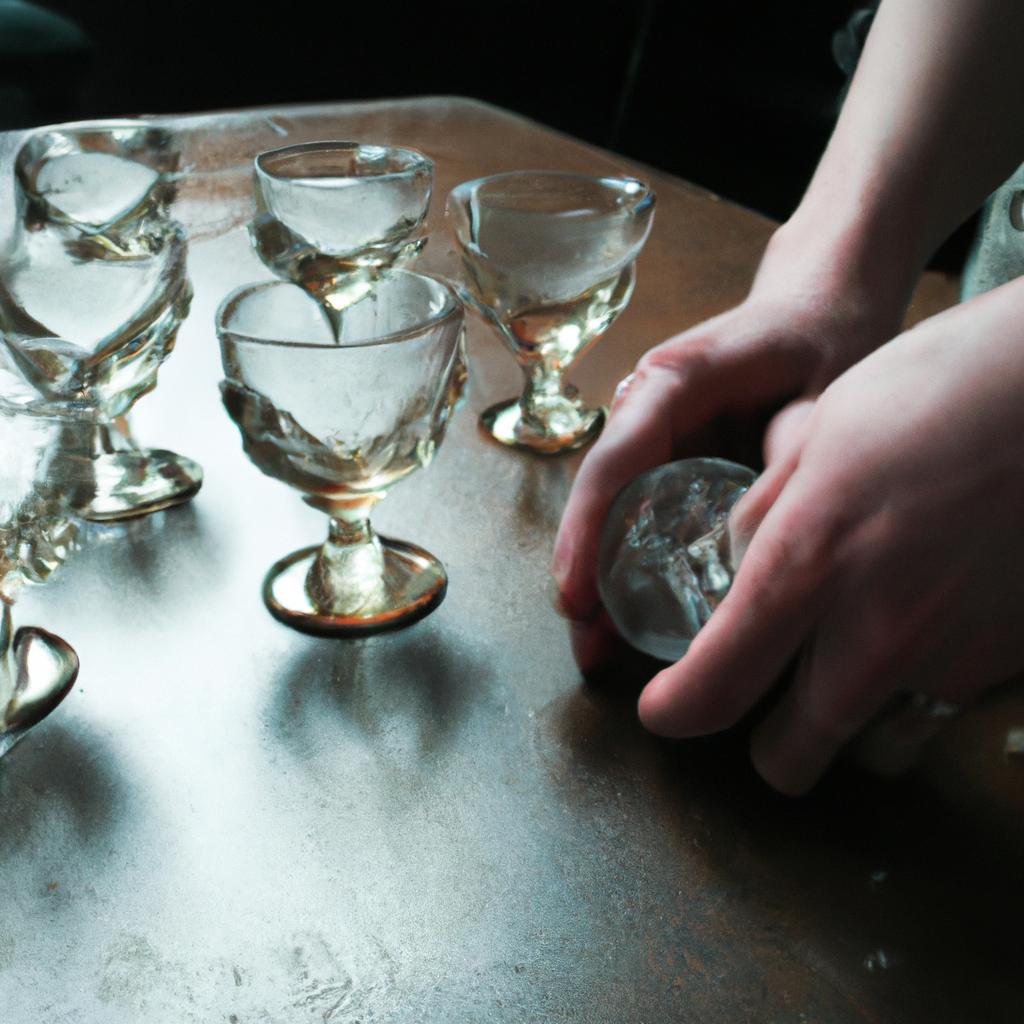Tips for Identifying Vintage Glassware: Antiques and Collectibles: Vintage Glassware
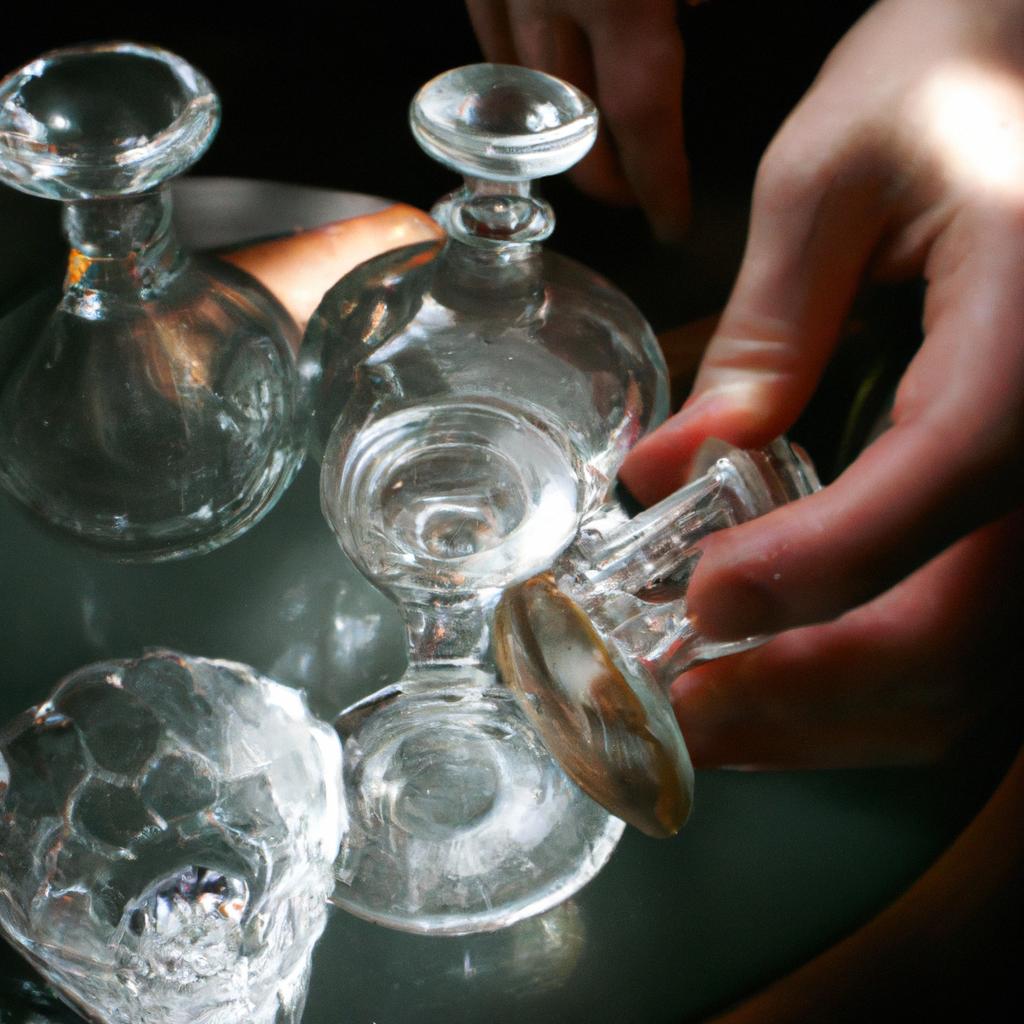
Glassware has long been a prized collectible, as it not only serves functional purposes but also carries historical and aesthetic value. Vintage glassware, in particular, holds a special allure for antique enthusiasts and collectors alike. However, identifying genuine vintage glassware can be a challenging endeavor due to the abundance of reproductions and imitations flooding the market. This article aims to provide readers with valuable tips on how to discern authentic vintage glassware from replicas by examining key characteristics such as material composition, design elements, and manufacturing techniques.
Take, for example, a hypothetical scenario where an individual stumbles upon an exquisite-looking glass pitcher at a flea market. Intrigued by its delicate craftsmanship and ornate patterns, they contemplate whether this piece is indeed a genuine vintage find or simply an imitation designed to deceive unknowing buyers. By following the guidance outlined in this article, one can learn to decipher clues that reveal the true age and worth of such pieces. Whether you are an avid collector seeking rare treasures or simply curious about the history behind these objects d’art, understanding the nuances of vintage glassware identification will undoubtedly enhance your appreciation for this timeless art form.
In order to effectively navigate through the vast sea of antiques and collectibles, it is imperative to equip yourself with the necessary knowledge and tools. First and foremost, familiarize yourself with different types of vintage glassware and their distinguishing features. Research popular manufacturers, patterns, and styles from different time periods to develop a comprehensive understanding of the market.
Next, examine the material composition of the glassware. Genuine vintage glassware is typically made of high-quality materials such as lead crystal or hand-blown glass. These materials often exhibit certain characteristics like weight, clarity, and brilliance that may differ from modern glassware. Look for signs of wear and age, such as scratches or fading on the surface, which can indicate authenticity.
Pay close attention to design elements and patterns on the glassware. Vintage pieces often feature intricate designs, etchings, or hand-painted details that require skilled craftsmanship. Look for consistency in design motifs, precise detailing, and evidence of handwork like tool marks or irregularities in shape.
Additionally, examine the manufacturing techniques used in creating the piece. Vintage glassware is commonly crafted using traditional methods like mold-pressing or hand-blowing. Familiarize yourself with these techniques to recognize their telltale signs on various parts of the glassware such as seams or pontil marks.
Lastly, seek expert opinions whenever possible. Consult reputable antique dealers or collectors who specialize in vintage glassware to gain valuable insights into specific pieces or manufacturers. They can provide expertise based on their years of experience handling authentic vintage items.
In conclusion, identifying genuine vintage glassware requires a combination of research, observation skills, and expert guidance. By understanding key characteristics such as material composition, design elements, and manufacturing techniques, you can confidently discern between authentic vintage pieces and imitations. Remember to approach your pursuit with patience and diligence as it takes time to develop a discerning eye for vintage treasures.
History of Glassmaking
Glass has been a prized material for centuries, with its origins dating back to ancient civilizations such as Egypt and Mesopotamia. The art of glassmaking has evolved over time, reflecting the advancements in technology and the creative expressions of different cultures. To understand vintage glassware, it is important to delve into the rich history of glass production.
One fascinating example that showcases the historical significance of antique glassware is the discovery of Roman glass vessels in Pompeii. These well-preserved artifacts provide valuable insights into the techniques and aesthetics employed by skilled artisans during this period. By examining these ancient pieces, historians have been able to trace the development of various decorative styles and patterns that are still sought after today.
When exploring the world of vintage glassware, there are several key aspects to consider:
- Craftsmanship: Vintage glassware often exhibits exceptional craftsmanship, characterized by intricate details and precision. The skillful manipulation of molten glass allowed artisans to create stunning designs, ranging from delicate etchings to elaborate cutwork.
- Colors: Antique glass comes in an array of captivating colors due to specific additives used during manufacturing processes. From vibrant cobalt blue to soft pastels, each hue adds depth and character to a piece.
- Patterns: Vintage glassware frequently features distinctive patterns that can help identify its origin or maker. A variety of techniques were employed, including pressed or molded designs, acid etching, and hand painting.
- Markings: Many vintage glass pieces bear identifying marks such as logos or signatures either on the base or elsewhere. These markings indicate renowned manufacturers or artists and can significantly enhance their value.
| Age | Color | Pattern |
|---|---|---|
| Early 20th century | Amber | Art Nouveau-inspired floral motifs |
| Mid-century | Emerald green | Atomic starbursts |
| Victorian era | Cranberry pink | Cranberry glass with gold enamel accents |
| Depression era | Clear | Ribbed design with vertical lines |
Understanding the history of glassmaking provides a foundation for identifying and appreciating vintage glassware. By recognizing the craftsmanship, colors, patterns, and markings associated with different eras, collectors can gain valuable insights into the authenticity and value of their pieces. In the subsequent section, we will explore some common types of vintage glassware, building upon this historical context to further enhance your knowledge in this fascinating realm.
Common Types of Vintage Glassware
To successfully identify vintage glassware, it is essential to familiarize oneself with certain key aspects and characteristics. By understanding the distinguishing features of different types of vintage glassware, collectors can make informed decisions regarding their purchases or valuations. This section will provide valuable tips on how to recognize vintage glassware effectively, allowing enthusiasts to navigate the world of antiques and collectibles with confidence.
Case Study:
Consider a hypothetical scenario where you stumble upon an intricately designed glass vase at a local antique shop. Its vibrant colors and delicate patterns immediately catch your eye, sparking curiosity about its origins and potential value. To determine if this vase is indeed a piece of vintage glassware, follow these useful guidelines:
Identifying Marks:
- Look for identifying marks or signatures engraved or embossed on the base or body of the glassware.
- Research these markings online or consult reference books that specialize in vintage glassware identification.
- Pay attention to well-known manufacturers or designers associated with high-quality vintage pieces.
Characteristics:
4. Observe the overall appearance and style of the glass item such as color variations, unique shapes, or intricate details.
5. Determine if any specific techniques were used during production, such as pressed glass, hand-blown methods, or cut glass designs.
6. Consider the era in which similar styles were popularized; this knowledge can aid in narrowing down the possible age range of the item.
Table: Characteristics Checklist
| Characteristic | Description |
|---|---|
| Color | Vibrant hues like cobalt blue, emerald green, or cranberry red are often indicative of vintage glassware |
| Pattern/Design | Elaborate motifs, intricate detailing, or distinct patterns can signify craftsmanship characteristic of particular eras |
| Weight | Vintage glass items tend to be heavier due to the use of thicker glass compared to modern counterparts |
| Imperfections | Minor flaws such as bubbles, tool marks, or slight irregularities in shape can suggest handcrafted vintage pieces |
By applying these tips and utilizing available resources, you will be better equipped to identify whether your glass vase is a valuable piece of vintage glassware. Remember that becoming familiar with different characteristics and techniques used during specific time periods is key to honing your expertise in this field.
Having explored methods for identifying vintage glassware, we will now delve into understanding the various distinguishing characteristics commonly found in these collectibles. By examining these traits closely, collectors can gain deeper insights into the historical context and craftsmanship associated with vintage glassware.
Characteristics of Vintage Glassware
Having explored the common types of vintage glassware, it is now essential to examine the characteristics that can help in identifying such pieces. By understanding these distinguishing features, collectors and enthusiasts can confidently assess whether a particular item is an authentic vintage piece or a modern reproduction.
Paragraph 1:
To illustrate how specific characteristics aid in identification, let’s consider an example. Imagine you come across a delicate glass vase with intricate floral engravings at an antique shop. It appears old but determining its age requires closer examination. Firstly, examining the base for pontil marks – rough or polished areas where the vase was detached from the blowpipe during manufacturing – can provide valuable insights into its authenticity. Additionally, checking for imperfections such as uneven thickness or bubbles within the glass can indicate hand-blown craftsmanship commonly found in vintage pieces.
Paragraph 2:
When attempting to identify vintage glassware, several key factors should be considered. These include:
- Transparency: Authentic vintage glass tends to have a higher level of clarity compared to newer reproductions.
- Weight: Genuine vintage items are often heavier due to their thicker walls and solid construction.
- Coloration: Vintage glass may exhibit unique color variations caused by chemical compositions or aging processes.
- Design motifs: Certain design elements like Art Deco patterns or elaborate etchings were prevalent during specific time periods.
Markdown bullet point list (evoking emotional response):
- Collecting vintage glassware allows us to cherish historical artifacts that embody artistry and skilled craftsmanship.
- Exploring different eras through these elegant pieces enables us to connect with past generations and their artistic sensibilities.
- The thrill of finding rare and valuable collectibles adds excitement and satisfaction to any collection.
- Sharing knowledge about vintage glassware fosters a sense of community among enthusiasts who appreciate its beauty and history.
Paragraph 3:
Another useful tool for evaluating potential vintage finds is by examining specific details. The following table outlines some key characteristics to consider when identifying vintage glassware:
| Characteristic | Description | Example |
|---|---|---|
| Pontil Marks | Rough or polished areas where the item was detached from the blowpipe during manufacturing. | Visible pontil mark on the base of a hand-blown wine glass. |
| Mold Lines | Thin lines found on molded glass pieces, indicating they were produced using molds rather than being handmade. | Faint mold lines running vertically along the sides of a pressed glass bowl. |
| Wear Patterns | Signs of wear and use that can indicate age, such as scratches on the bottom or rubbing marks from handling. | Light surface scratches on the base of a vintage crystal decanter. |
Transition sentence into the subsequent section about “Signs of Authenticity”:
By understanding these distinguishing features and evaluating specific characteristics, one can gain valuable insights into whether a piece of vintage glassware is truly authentic without relying solely on guesswork or intuition.
Signs of Authenticity
Imagine you stumble upon a beautiful glass vase at an antique store. Its intricate design and delicate craftsmanship make it appear to be vintage, but how can you be sure? One way to identify the authenticity of vintage glassware is by examining manufacturer marks or signatures. These unique imprints provide valuable clues about the age and origin of the piece.
Manufacturer marks come in various forms, including engraved logos, etched initials, or embossed symbols. For example, let’s consider a hypothetical scenario where you find a clear crystal bowl with an engraved mark that reads “Tiffany & Co.” This instantly adds value and credibility to your discovery since Tiffany & Co. has long been renowned for its exquisite glassware creations. By researching the specific manufacturer marks associated with different time periods and companies, collectors can pinpoint when and where their vintage glassware was produced.
To assist your identification process further, here are some key considerations regarding manufacturer marks:
- Variety: Different manufacturers implemented distinct marking styles throughout history, so familiarize yourself with common markings from well-known glassmakers such as Lalique, Waterford, Steuben, or Fenton.
- Consistency: Manufacturers often used consistent designs or patterns for their marks over time; look for these recurring motifs as they can help determine the approximate period of production.
- Quality: Pay attention to the quality of the mark itself—vintage pieces usually feature finely executed engravings or etchings rather than crude or poorly executed imprints.
- Location: The placement of the mark on the glass item may also offer insights into its authenticity. Research typical locations based on historical knowledge or consult reference books specialized in identifying vintage glassware.
By carefully examining manufacturer marks on vintage glassware using these considerations, enthusiasts gain significant insight into their collection’s origins and potential value. To illustrate this point visually, refer to the table below highlighting distinctive manufacturer marks and their associated time periods:
| Manufacturer | Mark Description | Time Period |
|---|---|---|
| Lalique | Signature etched in | 1920s – 1970s |
| cursive script | ||
| Waterford | Acid-etched seahorse | Late 20th |
| symbol with “Waterford” | century | |
| Steuben | Engraved signature on | Early to mid- |
| the base | 20th century | |
| Fenton | Embossed oval logo with | Mid-20th |
| the word “Fenton” | century |
Incorporating these insights into your search for vintage glassware will significantly enhance your ability to identify authentic pieces. Now that we have explored how manufacturer marks can help determine authenticity, let us delve into another crucial aspect of evaluating the condition of vintage glassware.
Understanding the importance of assessing a piece’s condition is vital when dealing with vintage glassware. Let’s explore some tips for evaluating its overall state in order to make informed decisions about potential purchases or valuing existing collections.
Tips for Evaluating Condition
Signs of Authenticity are important when identifying vintage glassware. By examining specific characteristics, collectors and enthusiasts can determine if a piece is truly vintage or a reproduction. For example, let’s consider the case of a collector who comes across a strikingly beautiful glass vase at an estate sale. The first step in determining its authenticity would be to examine the base for any marks or signatures that could indicate the manufacturer or designer.
There are several key signs to look out for when assessing the authenticity of vintage glassware:
- Quality: Vintage glassware tends to have higher quality craftsmanship compared to modern reproductions. Look closely at details such as the precision of cuts, clarity, and thickness of the glass.
- Age-related wear: Genuine vintage pieces may exhibit certain wear patterns consistent with their age, including scratches, fading colors, or tiny air bubbles trapped within the glass itself.
- Production methods: Familiarize yourself with different production techniques used during different time periods. For instance, hand-blown glass was more prevalent in older pieces while mold-pressed techniques became common in later years.
- Research and documentation: Consult reputable reference books or online resources dedicated to vintage glassware identification. These sources often provide valuable information on specific manufacturers’ markings, design styles popular during particular eras, and other helpful tips.
To further illustrate these points visually and evoke an emotional response from readers seeking guidance in identifying authentic vintage glassware, here is a bullet point list highlighting some practical considerations:
- Take your time when examining potential purchases
- Develop an eye for distinctive features indicative of genuine vintage pieces
- Utilize available resources like specialized forums or expert appraisers
- Remember that practice makes perfect – honing your knowledge requires hands-on experience
Additionally, we present you with a table showcasing commonly encountered manufacturing techniques alongside corresponding eras:
| Manufacturing Technique | Era |
|---|---|
| Hand-blown | 18th-19th century |
| Mold-pressed | Late 19th – early 20th century |
| Machine-made | Mid-20th century onwards |
By keeping these signs of authenticity in mind and utilizing available resources, you will be better equipped to identify genuine vintage glassware. In the subsequent section, we will explore different avenues where one can find such unique pieces with ease.
Where to Find Vintage Glassware
Transitioning smoothly from the previous section on evaluating condition, let us now delve into where one can find vintage glassware. Understanding the various sources and avenues available is crucial in expanding your collection or finding that unique piece you have been seeking.
Imagine you are a passionate collector of vintage glassware, particularly interested in mid-century modern designs. One day, while browsing through an online auction site, you stumble upon a rare set of vibrant Murano glass vases. Intrigued by the possibility of adding these exquisite pieces to your collection, you decide to explore further.
To aid collectors and enthusiasts like yourself in their quest for acquiring vintage glassware, here are some valuable pointers:
-
Antique Stores: Traditional antique stores often house a wide range of vintage glassware items. These establishments specialize in curating collections that cater to diverse tastes and interests. Visiting such stores allows you to physically examine the merchandise and engage with knowledgeable staff who can provide insights into different styles and periods.
-
Flea Markets and Estate Sales: These venues offer opportunities to discover hidden gems at more affordable prices. Flea markets attract vendors selling an array of antiques and collectibles, including vintage glassware. Similarly, estate sales occur when properties are liquidated due to relocation or inheritance matters, presenting chances to uncover well-preserved glassware treasures.
-
Online Marketplaces: The advent of e-commerce has revolutionized the buying and selling experience for vintage glassware enthusiasts worldwide. Websites dedicated solely to antiques and collectibles host numerous listings offering exceptional selections from various eras and regions. Virtual marketplaces enable easy access regardless of geographical location.
-
Social Media Groups and Forums: Engaging with fellow collectors through social media groups or online forums can provide valuable insights and lead to potential acquisitions. These platforms serve as thriving communities where individuals share their knowledge, experiences, and even trade or sell vintage glassware items.
Now let’s explore a table that showcases the advantages and considerations associated with each source:
| Source | Advantages | Considerations |
|---|---|---|
| Antique Stores | – Physical examination of merchandise | – Potentially higher prices |
| Flea Markets | – Opportunity for finding affordable treasures | – Limited availability |
| Online Marketplaces | – Wide range of options from various regions | – Inability to physically examine the item |
| Social Media Groups/Forums | – Networking opportunities with collectors | – Reliance on individual sellers’ credibility |
By employing these strategies and utilizing different sources, you can enhance your chances of acquiring unique vintage glassware pieces for your collection. Remember to exercise caution when making purchases, verify authenticity whenever possible, and stay informed about current market trends.
In summary, identifying where to find vintage glassware involves exploring various avenues such as antique stores, flea markets, online marketplaces, and social media groups or forums. Each source offers distinct advantages and considerations that need to be taken into account during the acquisition process. With perseverance and careful research, you are sure to uncover remarkable additions to your vintage glassware collection.

